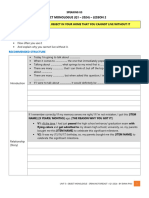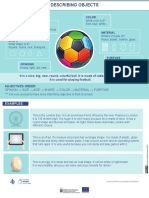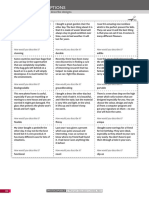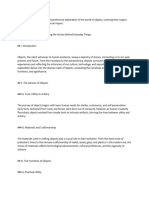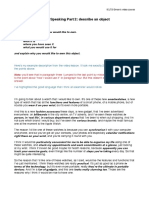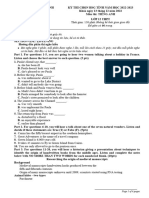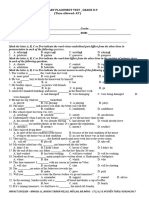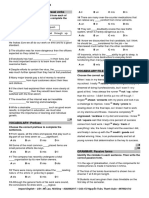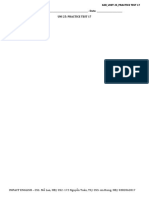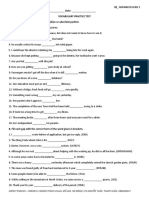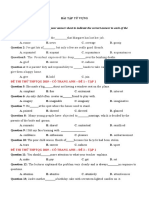When describing an object in IELTS Writing Task 1, you can use the following structures and vocabulary:
1. Introduction:
- Introduce the object and provide a brief description of its appearance or purpose.
Example: The diagram shows how the cutting tool in the Stone Age were advanced.
Overview:
Overall, the stone tool, after 0.6 million years, was developed into a more refined and sharper for cutting.
2. Size and dimensions:
- Provide details about the size, dimensions, or measurements of the object.
Example: The object is approximately X centimeters/meters tall/wide/deep.
3. Shape and color:
- Describe the shape and color of the object.
Example: The object has a rectangular shape and is predominantly blue in color.
4. Material:
- Mention the material from which the object is made.
Example: The object is made of/constructed from metal/wood/plastic, etc.
5. Parts and components:
- Describe the different parts or components of the object and their functions.
Example: The object consists of several parts, including a handle, buttons, and a screen.
6. Purpose and functionality:
- Explain the purpose of the object and how it is used.
Example: The object is designed for... It is used to...
7. Special features:
- Highlight any unique or special features of the object.
Example: Additionally, the object is equipped with... It also has the ability to...
8. Descriptive language:
- Use descriptive adjectives and adverbs to provide a vivid description.
Example: The object is sleek, compact, and aesthetically pleasing. It functions efficiently and smoothly.
9. Conclusion:
- Summarize the main characteristics of the object.
Example: In conclusion, the object is a versatile and practical tool/device that serves its intended purpose
effectively.
Vocabulary and language:
- Nouns: object, item, device, tool, equipment, appliance, gadget, machine, instrument, apparatus.
- Adjectives: small, large, compact, lightweight, sturdy, durable, portable, elegant, sophisticated, innovative, user-
friendly, multifunctional.
- Colors: black, white, gray, red, blue, green, yellow, etc.
- Shapes: rectangular, circular, cylindrical, triangular, square, etc.
- Materials: metal, plastic, glass, wood, fabric, ceramic, etc.
ADVANCED STRUCTURES AND VOCABULARY
1. Physical characteristics:
- Emphasize specific physical characteristics of the object, such as texture, weight, or intricate details.
Example: The object boasts a lustrous metallic finish, exuding an air of sophistication and opulence. Its feather-
light weight and seamless contours make it a pleasure to handle.
2. Functional versatility:
� - Highlight the various functions and applications of the object, showcasing its adaptability.
Example: From capturing breathtaking photographs with its high-resolution lens to effortlessly executing complex
computational tasks, this object seamlessly blurs the line between a cutting-edge camera and a powerful computing
device.
3. Technological advancements:
- Discuss the state-of-the-art technologies or advanced features incorporated into the object.
Example: Equipped with state-of-the-art biometric authentication, the object ensures unrivaled security and
privacy. Its integration of artificial intelligence algorithms enables intuitive and personalized user experiences.
4. User experience:
- Describe how the object enhances the user experience or simplifies daily tasks.
Example: The object's intuitive interface and user-friendly controls empower individuals to navigate effortlessly
through its myriad features, making it an indispensable companion for both novices and tech-savvy enthusiasts alike.
5. Environmental sustainability:
- Discuss any eco-friendly or sustainable aspects associated with the object.
Example: Built with a deep commitment to environmental conservation, the object harnesses renewable energy
sources and employs eco-conscious manufacturing processes, minimizing its carbon footprint and contributing to a
greener future.
6. Innovative design:
- Highlight any unique or groundbreaking design elements that set the object apart.
Example: The object's avant-garde design seamlessly fuses sleek minimalism with artistic flair, creating an
aesthetically captivating masterpiece that transcends mere functionality.
7. Impact on society:
- Reflect on the broader implications or societal impact of the object.
Example: As a catalyst for connectivity and global communication, this object has revolutionized the way
individuals interact, breaking down barriers and fostering a sense of unity in an increasingly interconnected world.
Vocabulary and language:
- Nouns: epitome, innovation, convenience, opulence, authentication, algorithms, intuitive interface, user-friendly
controls, sustainability, avant-garde design, connectivity, global communication.
- Adjectives: sleek, ergonomic, lustrous, feather-light, seamless, cutting-edge, powerful, unrivaled, personalized,
intuitive, eco-friendly, sustainable, groundbreaking, aesthetically captivating, interconnected.
- Verbs: encapsulate, boast, exude, handle, execute, navigate, empower, harness, employ, minimize, transcend,
revolutionize, foster.















